Environmental and Social Analysis of the Boston Big Dig Project
VerifiedAdded on 2022/09/07
|10
|2929
|13
Project
AI Summary
This project analyzes the Big Dig, a massive infrastructure project in Boston, focusing on its environmental and social impacts. It examines the project's inception, objectives, and the challenges encountered during its execution, including cost overruns, design flaws, and traffic congestion. The analysis delves into the project's impact on the urban landscape, including the creation of parks and open spaces, and its effects on public health and community perception. It also explores the solutions implemented to address the issues and the reactions of the people. The project highlights the complex interplay between urban design, infrastructure development, and its effects on the environment and social well-being. The document also discusses the project's evolution and its impact on the city's infrastructure, traffic flow, and urban vitality, examining the positive and negative consequences. The project also includes references to the urban form, human uses, and the impact of the community.
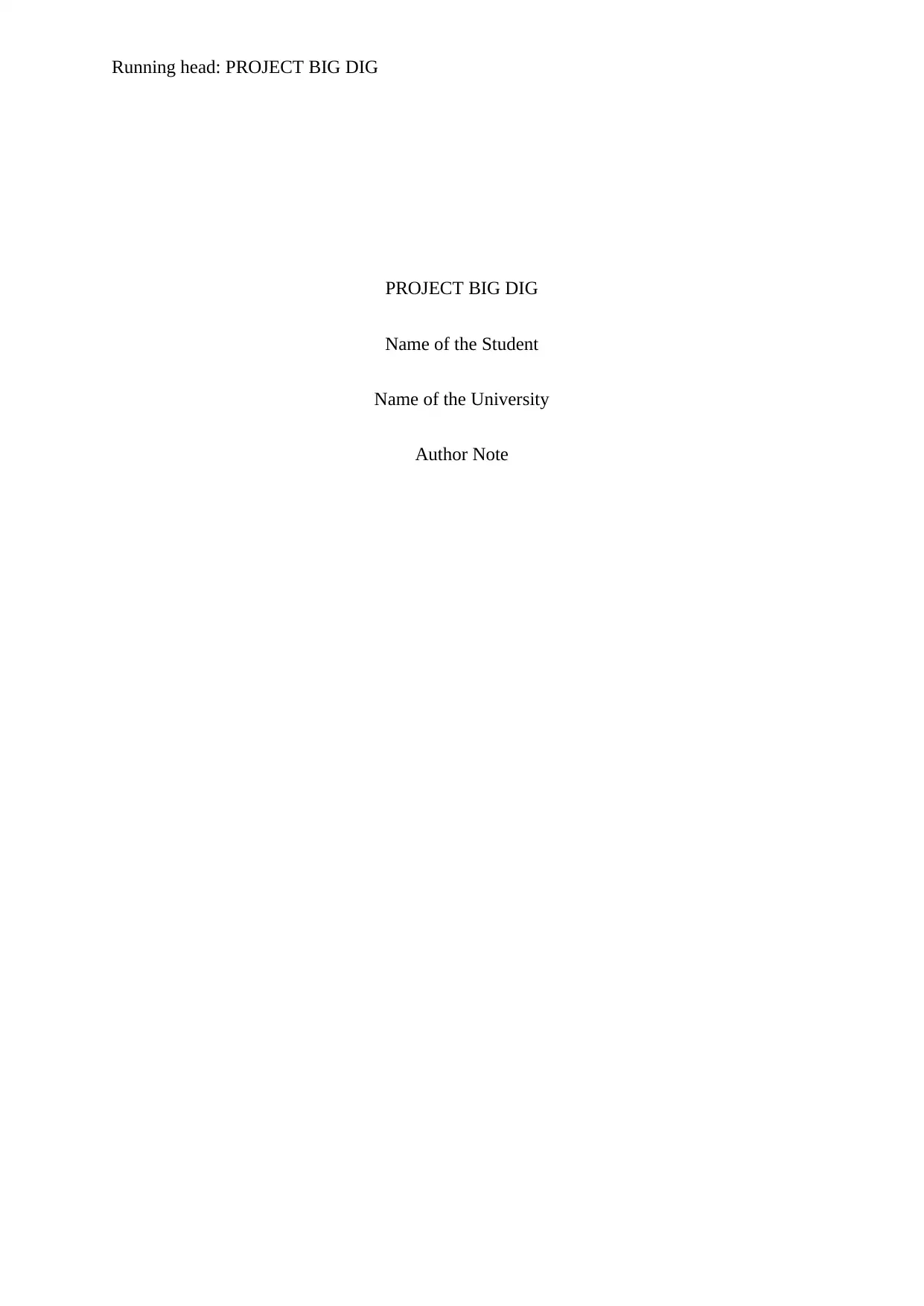
Running head: PROJECT BIG DIG
PROJECT BIG DIG
Name of the Student
Name of the University
Author Note
PROJECT BIG DIG
Name of the Student
Name of the University
Author Note
Paraphrase This Document
Need a fresh take? Get an instant paraphrase of this document with our AI Paraphraser
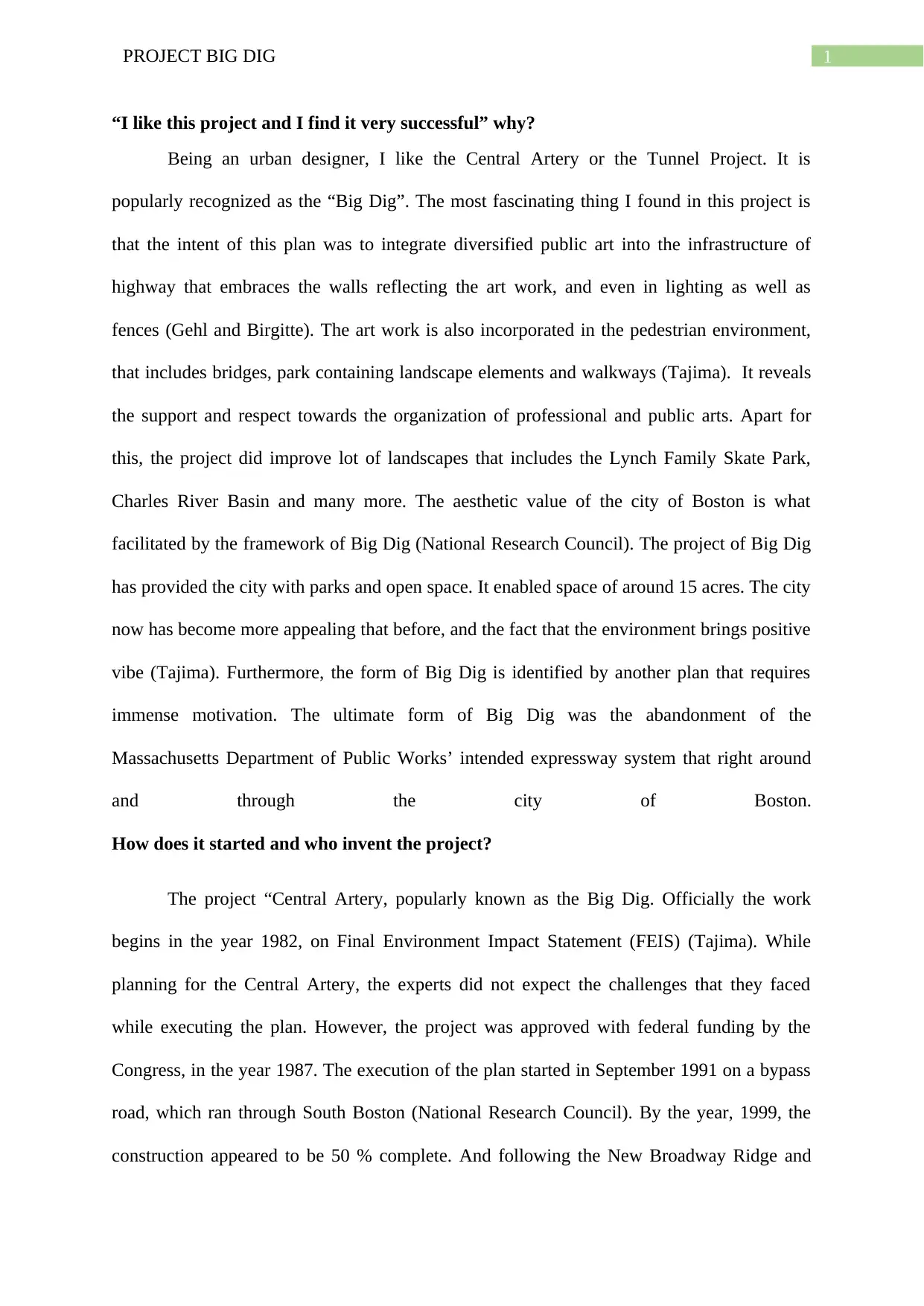
1PROJECT BIG DIG
“I like this project and I find it very successful” why?
Being an urban designer, I like the Central Artery or the Tunnel Project. It is
popularly recognized as the “Big Dig”. The most fascinating thing I found in this project is
that the intent of this plan was to integrate diversified public art into the infrastructure of
highway that embraces the walls reflecting the art work, and even in lighting as well as
fences (Gehl and Birgitte). The art work is also incorporated in the pedestrian environment,
that includes bridges, park containing landscape elements and walkways (Tajima). It reveals
the support and respect towards the organization of professional and public arts. Apart for
this, the project did improve lot of landscapes that includes the Lynch Family Skate Park,
Charles River Basin and many more. The aesthetic value of the city of Boston is what
facilitated by the framework of Big Dig (National Research Council). The project of Big Dig
has provided the city with parks and open space. It enabled space of around 15 acres. The city
now has become more appealing that before, and the fact that the environment brings positive
vibe (Tajima). Furthermore, the form of Big Dig is identified by another plan that requires
immense motivation. The ultimate form of Big Dig was the abandonment of the
Massachusetts Department of Public Works’ intended expressway system that right around
and through the city of Boston.
How does it started and who invent the project?
The project “Central Artery, popularly known as the Big Dig. Officially the work
begins in the year 1982, on Final Environment Impact Statement (FEIS) (Tajima). While
planning for the Central Artery, the experts did not expect the challenges that they faced
while executing the plan. However, the project was approved with federal funding by the
Congress, in the year 1987. The execution of the plan started in September 1991 on a bypass
road, which ran through South Boston (National Research Council). By the year, 1999, the
construction appeared to be 50 % complete. And following the New Broadway Ridge and
“I like this project and I find it very successful” why?
Being an urban designer, I like the Central Artery or the Tunnel Project. It is
popularly recognized as the “Big Dig”. The most fascinating thing I found in this project is
that the intent of this plan was to integrate diversified public art into the infrastructure of
highway that embraces the walls reflecting the art work, and even in lighting as well as
fences (Gehl and Birgitte). The art work is also incorporated in the pedestrian environment,
that includes bridges, park containing landscape elements and walkways (Tajima). It reveals
the support and respect towards the organization of professional and public arts. Apart for
this, the project did improve lot of landscapes that includes the Lynch Family Skate Park,
Charles River Basin and many more. The aesthetic value of the city of Boston is what
facilitated by the framework of Big Dig (National Research Council). The project of Big Dig
has provided the city with parks and open space. It enabled space of around 15 acres. The city
now has become more appealing that before, and the fact that the environment brings positive
vibe (Tajima). Furthermore, the form of Big Dig is identified by another plan that requires
immense motivation. The ultimate form of Big Dig was the abandonment of the
Massachusetts Department of Public Works’ intended expressway system that right around
and through the city of Boston.
How does it started and who invent the project?
The project “Central Artery, popularly known as the Big Dig. Officially the work
begins in the year 1982, on Final Environment Impact Statement (FEIS) (Tajima). While
planning for the Central Artery, the experts did not expect the challenges that they faced
while executing the plan. However, the project was approved with federal funding by the
Congress, in the year 1987. The execution of the plan started in September 1991 on a bypass
road, which ran through South Boston (National Research Council). By the year, 1999, the
construction appeared to be 50 % complete. And following the New Broadway Ridge and
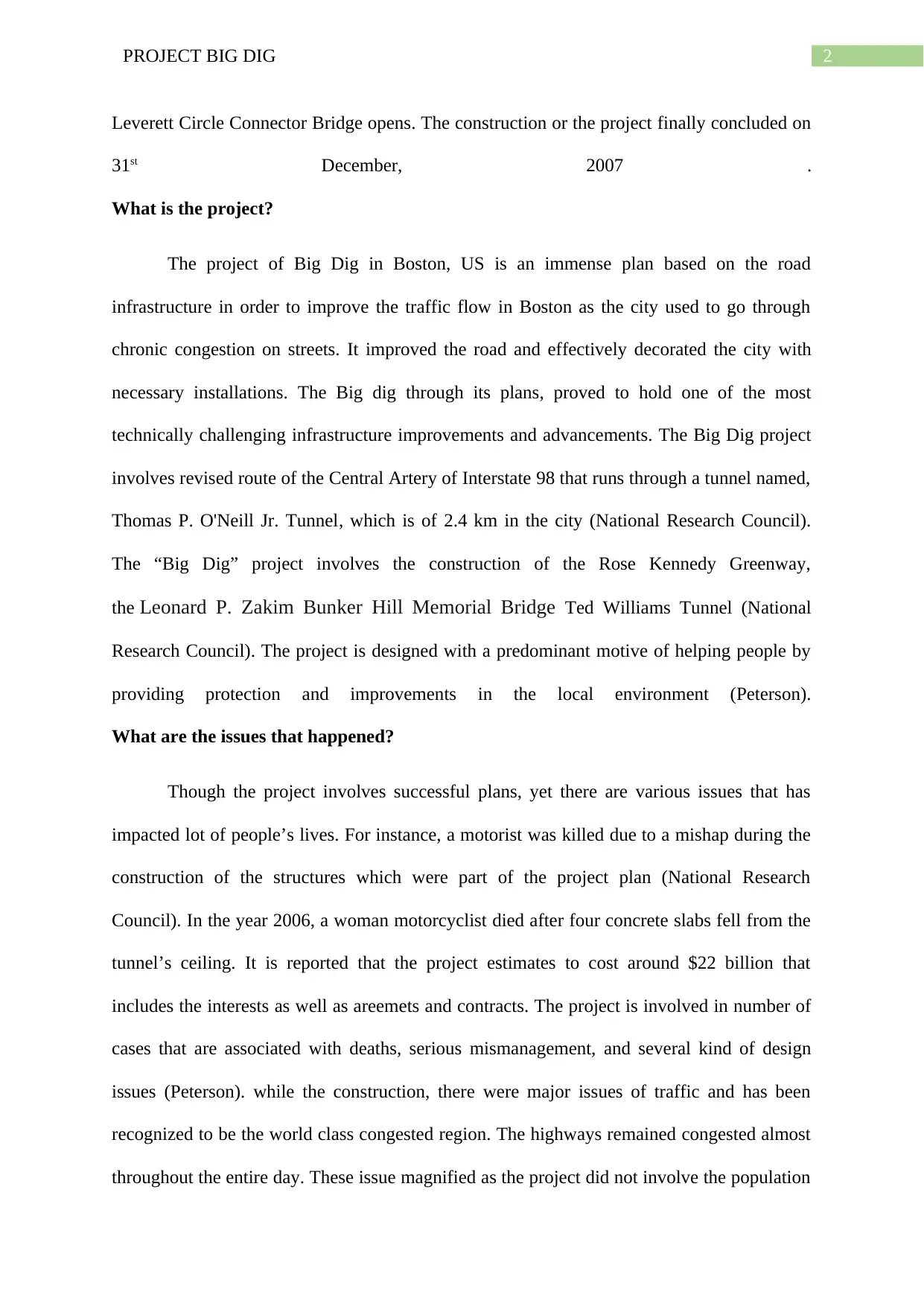
2PROJECT BIG DIG
Leverett Circle Connector Bridge opens. The construction or the project finally concluded on
31st December, 2007 .
What is the project?
The project of Big Dig in Boston, US is an immense plan based on the road
infrastructure in order to improve the traffic flow in Boston as the city used to go through
chronic congestion on streets. It improved the road and effectively decorated the city with
necessary installations. The Big dig through its plans, proved to hold one of the most
technically challenging infrastructure improvements and advancements. The Big Dig project
involves revised route of the Central Artery of Interstate 98 that runs through a tunnel named,
Thomas P. O'Neill Jr. Tunnel, which is of 2.4 km in the city (National Research Council).
The “Big Dig” project involves the construction of the Rose Kennedy Greenway,
the Leonard P. Zakim Bunker Hill Memorial Bridge Ted Williams Tunnel (National
Research Council). The project is designed with a predominant motive of helping people by
providing protection and improvements in the local environment (Peterson).
What are the issues that happened?
Though the project involves successful plans, yet there are various issues that has
impacted lot of people’s lives. For instance, a motorist was killed due to a mishap during the
construction of the structures which were part of the project plan (National Research
Council). In the year 2006, a woman motorcyclist died after four concrete slabs fell from the
tunnel’s ceiling. It is reported that the project estimates to cost around $22 billion that
includes the interests as well as areemets and contracts. The project is involved in number of
cases that are associated with deaths, serious mismanagement, and several kind of design
issues (Peterson). while the construction, there were major issues of traffic and has been
recognized to be the world class congested region. The highways remained congested almost
throughout the entire day. These issue magnified as the project did not involve the population
Leverett Circle Connector Bridge opens. The construction or the project finally concluded on
31st December, 2007 .
What is the project?
The project of Big Dig in Boston, US is an immense plan based on the road
infrastructure in order to improve the traffic flow in Boston as the city used to go through
chronic congestion on streets. It improved the road and effectively decorated the city with
necessary installations. The Big dig through its plans, proved to hold one of the most
technically challenging infrastructure improvements and advancements. The Big Dig project
involves revised route of the Central Artery of Interstate 98 that runs through a tunnel named,
Thomas P. O'Neill Jr. Tunnel, which is of 2.4 km in the city (National Research Council).
The “Big Dig” project involves the construction of the Rose Kennedy Greenway,
the Leonard P. Zakim Bunker Hill Memorial Bridge Ted Williams Tunnel (National
Research Council). The project is designed with a predominant motive of helping people by
providing protection and improvements in the local environment (Peterson).
What are the issues that happened?
Though the project involves successful plans, yet there are various issues that has
impacted lot of people’s lives. For instance, a motorist was killed due to a mishap during the
construction of the structures which were part of the project plan (National Research
Council). In the year 2006, a woman motorcyclist died after four concrete slabs fell from the
tunnel’s ceiling. It is reported that the project estimates to cost around $22 billion that
includes the interests as well as areemets and contracts. The project is involved in number of
cases that are associated with deaths, serious mismanagement, and several kind of design
issues (Peterson). while the construction, there were major issues of traffic and has been
recognized to be the world class congested region. The highways remained congested almost
throughout the entire day. These issue magnified as the project did not involve the population
⊘ This is a preview!⊘
Do you want full access?
Subscribe today to unlock all pages.

Trusted by 1+ million students worldwide
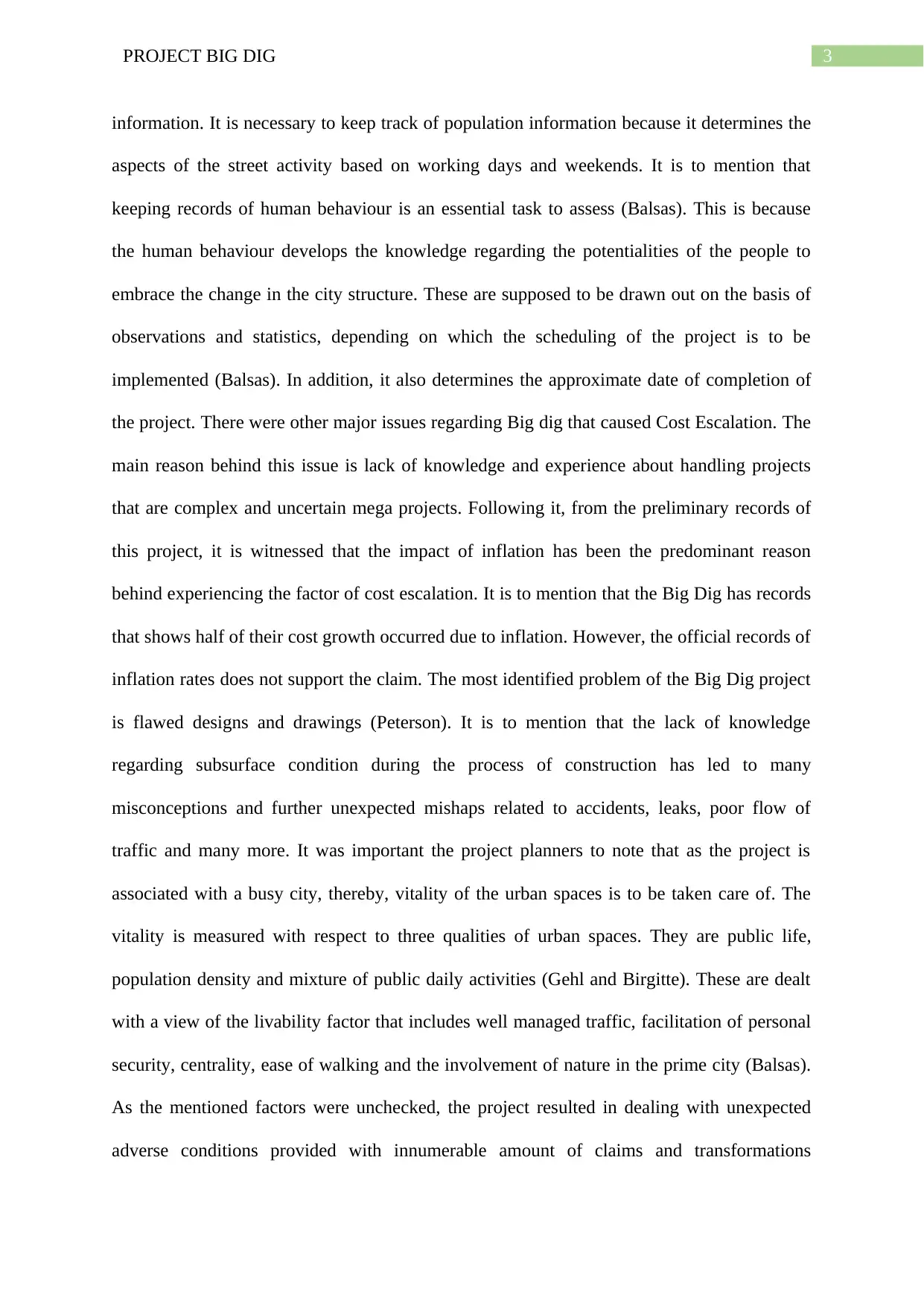
3PROJECT BIG DIG
information. It is necessary to keep track of population information because it determines the
aspects of the street activity based on working days and weekends. It is to mention that
keeping records of human behaviour is an essential task to assess (Balsas). This is because
the human behaviour develops the knowledge regarding the potentialities of the people to
embrace the change in the city structure. These are supposed to be drawn out on the basis of
observations and statistics, depending on which the scheduling of the project is to be
implemented (Balsas). In addition, it also determines the approximate date of completion of
the project. There were other major issues regarding Big dig that caused Cost Escalation. The
main reason behind this issue is lack of knowledge and experience about handling projects
that are complex and uncertain mega projects. Following it, from the preliminary records of
this project, it is witnessed that the impact of inflation has been the predominant reason
behind experiencing the factor of cost escalation. It is to mention that the Big Dig has records
that shows half of their cost growth occurred due to inflation. However, the official records of
inflation rates does not support the claim. The most identified problem of the Big Dig project
is flawed designs and drawings (Peterson). It is to mention that the lack of knowledge
regarding subsurface condition during the process of construction has led to many
misconceptions and further unexpected mishaps related to accidents, leaks, poor flow of
traffic and many more. It was important the project planners to note that as the project is
associated with a busy city, thereby, vitality of the urban spaces is to be taken care of. The
vitality is measured with respect to three qualities of urban spaces. They are public life,
population density and mixture of public daily activities (Gehl and Birgitte). These are dealt
with a view of the livability factor that includes well managed traffic, facilitation of personal
security, centrality, ease of walking and the involvement of nature in the prime city (Balsas).
As the mentioned factors were unchecked, the project resulted in dealing with unexpected
adverse conditions provided with innumerable amount of claims and transformations
information. It is necessary to keep track of population information because it determines the
aspects of the street activity based on working days and weekends. It is to mention that
keeping records of human behaviour is an essential task to assess (Balsas). This is because
the human behaviour develops the knowledge regarding the potentialities of the people to
embrace the change in the city structure. These are supposed to be drawn out on the basis of
observations and statistics, depending on which the scheduling of the project is to be
implemented (Balsas). In addition, it also determines the approximate date of completion of
the project. There were other major issues regarding Big dig that caused Cost Escalation. The
main reason behind this issue is lack of knowledge and experience about handling projects
that are complex and uncertain mega projects. Following it, from the preliminary records of
this project, it is witnessed that the impact of inflation has been the predominant reason
behind experiencing the factor of cost escalation. It is to mention that the Big Dig has records
that shows half of their cost growth occurred due to inflation. However, the official records of
inflation rates does not support the claim. The most identified problem of the Big Dig project
is flawed designs and drawings (Peterson). It is to mention that the lack of knowledge
regarding subsurface condition during the process of construction has led to many
misconceptions and further unexpected mishaps related to accidents, leaks, poor flow of
traffic and many more. It was important the project planners to note that as the project is
associated with a busy city, thereby, vitality of the urban spaces is to be taken care of. The
vitality is measured with respect to three qualities of urban spaces. They are public life,
population density and mixture of public daily activities (Gehl and Birgitte). These are dealt
with a view of the livability factor that includes well managed traffic, facilitation of personal
security, centrality, ease of walking and the involvement of nature in the prime city (Balsas).
As the mentioned factors were unchecked, the project resulted in dealing with unexpected
adverse conditions provided with innumerable amount of claims and transformations
Paraphrase This Document
Need a fresh take? Get an instant paraphrase of this document with our AI Paraphraser
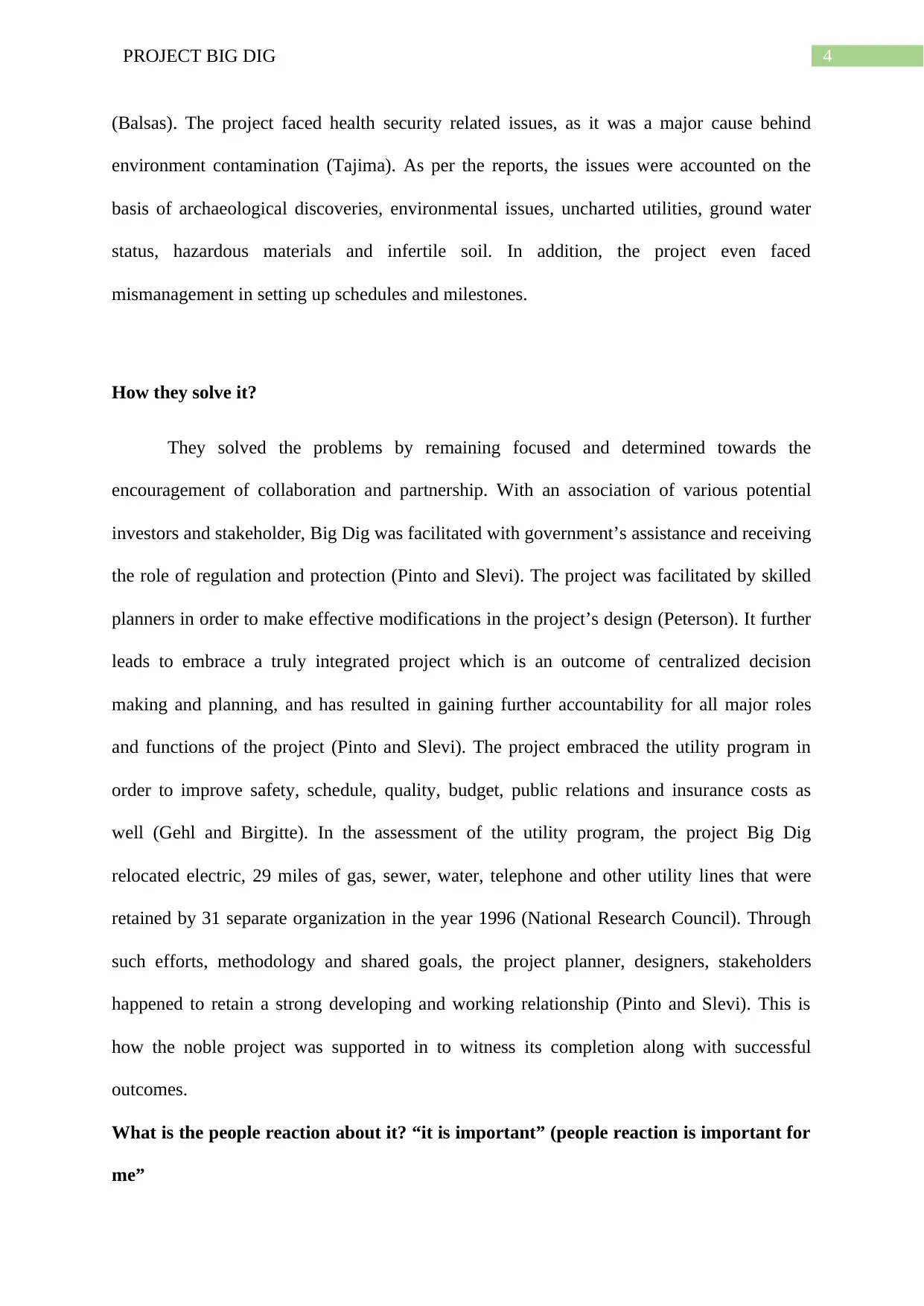
4PROJECT BIG DIG
(Balsas). The project faced health security related issues, as it was a major cause behind
environment contamination (Tajima). As per the reports, the issues were accounted on the
basis of archaeological discoveries, environmental issues, uncharted utilities, ground water
status, hazardous materials and infertile soil. In addition, the project even faced
mismanagement in setting up schedules and milestones.
How they solve it?
They solved the problems by remaining focused and determined towards the
encouragement of collaboration and partnership. With an association of various potential
investors and stakeholder, Big Dig was facilitated with government’s assistance and receiving
the role of regulation and protection (Pinto and Slevi). The project was facilitated by skilled
planners in order to make effective modifications in the project’s design (Peterson). It further
leads to embrace a truly integrated project which is an outcome of centralized decision
making and planning, and has resulted in gaining further accountability for all major roles
and functions of the project (Pinto and Slevi). The project embraced the utility program in
order to improve safety, schedule, quality, budget, public relations and insurance costs as
well (Gehl and Birgitte). In the assessment of the utility program, the project Big Dig
relocated electric, 29 miles of gas, sewer, water, telephone and other utility lines that were
retained by 31 separate organization in the year 1996 (National Research Council). Through
such efforts, methodology and shared goals, the project planner, designers, stakeholders
happened to retain a strong developing and working relationship (Pinto and Slevi). This is
how the noble project was supported in to witness its completion along with successful
outcomes.
What is the people reaction about it? “it is important” (people reaction is important for
me”
(Balsas). The project faced health security related issues, as it was a major cause behind
environment contamination (Tajima). As per the reports, the issues were accounted on the
basis of archaeological discoveries, environmental issues, uncharted utilities, ground water
status, hazardous materials and infertile soil. In addition, the project even faced
mismanagement in setting up schedules and milestones.
How they solve it?
They solved the problems by remaining focused and determined towards the
encouragement of collaboration and partnership. With an association of various potential
investors and stakeholder, Big Dig was facilitated with government’s assistance and receiving
the role of regulation and protection (Pinto and Slevi). The project was facilitated by skilled
planners in order to make effective modifications in the project’s design (Peterson). It further
leads to embrace a truly integrated project which is an outcome of centralized decision
making and planning, and has resulted in gaining further accountability for all major roles
and functions of the project (Pinto and Slevi). The project embraced the utility program in
order to improve safety, schedule, quality, budget, public relations and insurance costs as
well (Gehl and Birgitte). In the assessment of the utility program, the project Big Dig
relocated electric, 29 miles of gas, sewer, water, telephone and other utility lines that were
retained by 31 separate organization in the year 1996 (National Research Council). Through
such efforts, methodology and shared goals, the project planner, designers, stakeholders
happened to retain a strong developing and working relationship (Pinto and Slevi). This is
how the noble project was supported in to witness its completion along with successful
outcomes.
What is the people reaction about it? “it is important” (people reaction is important for
me”
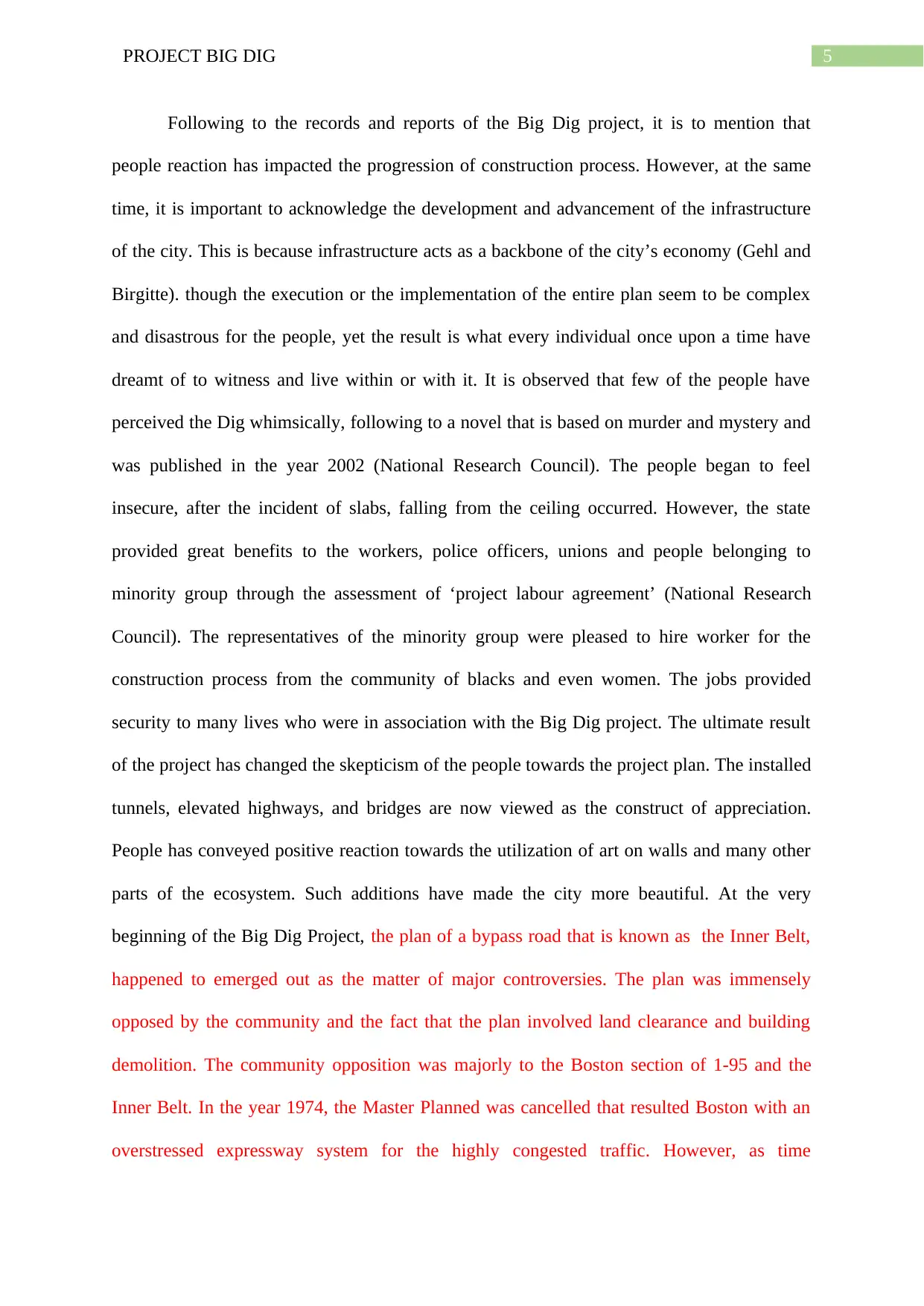
5PROJECT BIG DIG
Following to the records and reports of the Big Dig project, it is to mention that
people reaction has impacted the progression of construction process. However, at the same
time, it is important to acknowledge the development and advancement of the infrastructure
of the city. This is because infrastructure acts as a backbone of the city’s economy (Gehl and
Birgitte). though the execution or the implementation of the entire plan seem to be complex
and disastrous for the people, yet the result is what every individual once upon a time have
dreamt of to witness and live within or with it. It is observed that few of the people have
perceived the Dig whimsically, following to a novel that is based on murder and mystery and
was published in the year 2002 (National Research Council). The people began to feel
insecure, after the incident of slabs, falling from the ceiling occurred. However, the state
provided great benefits to the workers, police officers, unions and people belonging to
minority group through the assessment of ‘project labour agreement’ (National Research
Council). The representatives of the minority group were pleased to hire worker for the
construction process from the community of blacks and even women. The jobs provided
security to many lives who were in association with the Big Dig project. The ultimate result
of the project has changed the skepticism of the people towards the project plan. The installed
tunnels, elevated highways, and bridges are now viewed as the construct of appreciation.
People has conveyed positive reaction towards the utilization of art on walls and many other
parts of the ecosystem. Such additions have made the city more beautiful. At the very
beginning of the Big Dig Project, the plan of a bypass road that is known as the Inner Belt,
happened to emerged out as the matter of major controversies. The plan was immensely
opposed by the community and the fact that the plan involved land clearance and building
demolition. The community opposition was majorly to the Boston section of 1-95 and the
Inner Belt. In the year 1974, the Master Planned was cancelled that resulted Boston with an
overstressed expressway system for the highly congested traffic. However, as time
Following to the records and reports of the Big Dig project, it is to mention that
people reaction has impacted the progression of construction process. However, at the same
time, it is important to acknowledge the development and advancement of the infrastructure
of the city. This is because infrastructure acts as a backbone of the city’s economy (Gehl and
Birgitte). though the execution or the implementation of the entire plan seem to be complex
and disastrous for the people, yet the result is what every individual once upon a time have
dreamt of to witness and live within or with it. It is observed that few of the people have
perceived the Dig whimsically, following to a novel that is based on murder and mystery and
was published in the year 2002 (National Research Council). The people began to feel
insecure, after the incident of slabs, falling from the ceiling occurred. However, the state
provided great benefits to the workers, police officers, unions and people belonging to
minority group through the assessment of ‘project labour agreement’ (National Research
Council). The representatives of the minority group were pleased to hire worker for the
construction process from the community of blacks and even women. The jobs provided
security to many lives who were in association with the Big Dig project. The ultimate result
of the project has changed the skepticism of the people towards the project plan. The installed
tunnels, elevated highways, and bridges are now viewed as the construct of appreciation.
People has conveyed positive reaction towards the utilization of art on walls and many other
parts of the ecosystem. Such additions have made the city more beautiful. At the very
beginning of the Big Dig Project, the plan of a bypass road that is known as the Inner Belt,
happened to emerged out as the matter of major controversies. The plan was immensely
opposed by the community and the fact that the plan involved land clearance and building
demolition. The community opposition was majorly to the Boston section of 1-95 and the
Inner Belt. In the year 1974, the Master Planned was cancelled that resulted Boston with an
overstressed expressway system for the highly congested traffic. However, as time
⊘ This is a preview!⊘
Do you want full access?
Subscribe today to unlock all pages.

Trusted by 1+ million students worldwide
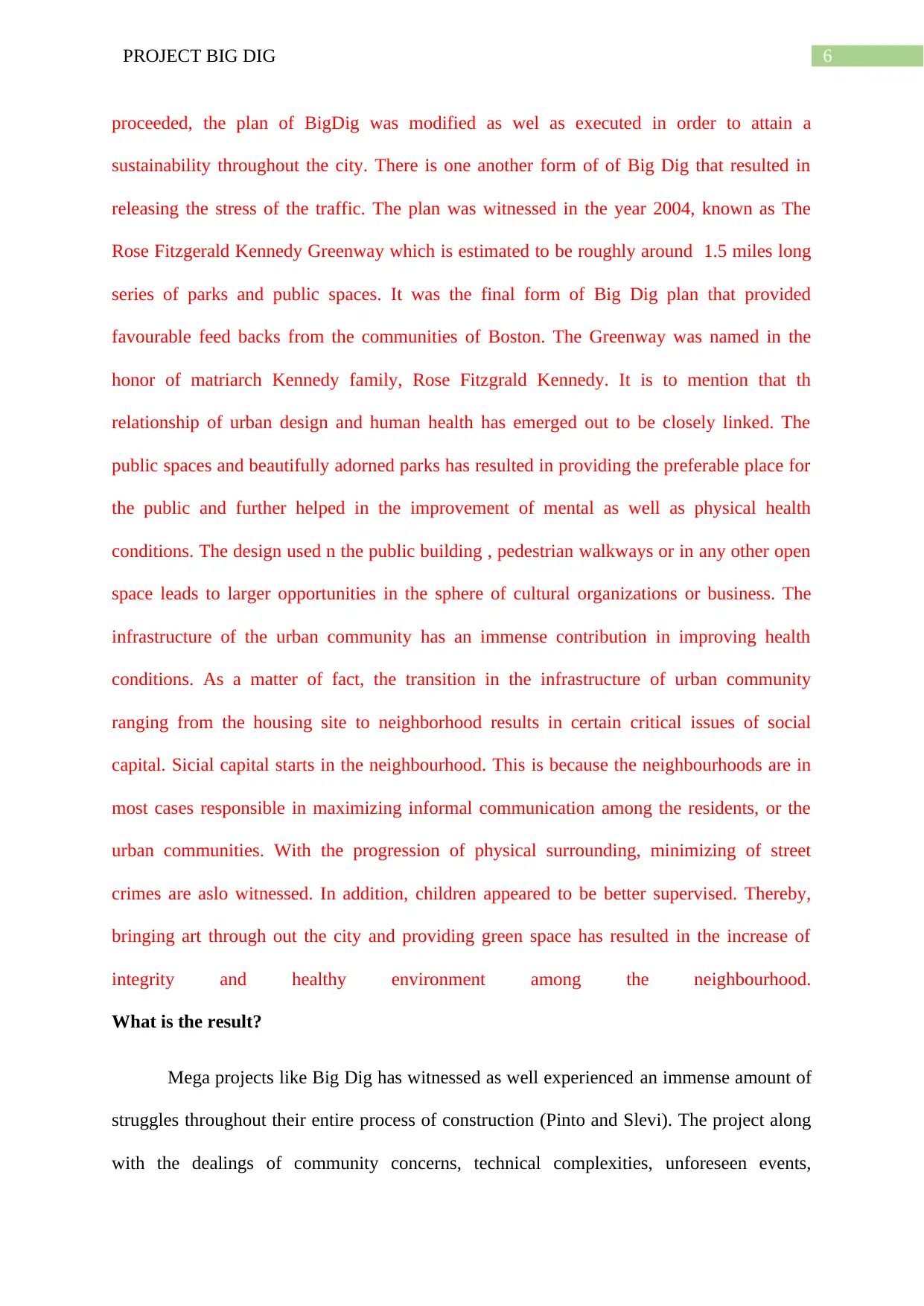
6PROJECT BIG DIG
proceeded, the plan of BigDig was modified as wel as executed in order to attain a
sustainability throughout the city. There is one another form of of Big Dig that resulted in
releasing the stress of the traffic. The plan was witnessed in the year 2004, known as The
Rose Fitzgerald Kennedy Greenway which is estimated to be roughly around 1.5 miles long
series of parks and public spaces. It was the final form of Big Dig plan that provided
favourable feed backs from the communities of Boston. The Greenway was named in the
honor of matriarch Kennedy family, Rose Fitzgrald Kennedy. It is to mention that th
relationship of urban design and human health has emerged out to be closely linked. The
public spaces and beautifully adorned parks has resulted in providing the preferable place for
the public and further helped in the improvement of mental as well as physical health
conditions. The design used n the public building , pedestrian walkways or in any other open
space leads to larger opportunities in the sphere of cultural organizations or business. The
infrastructure of the urban community has an immense contribution in improving health
conditions. As a matter of fact, the transition in the infrastructure of urban community
ranging from the housing site to neighborhood results in certain critical issues of social
capital. Sicial capital starts in the neighbourhood. This is because the neighbourhoods are in
most cases responsible in maximizing informal communication among the residents, or the
urban communities. With the progression of physical surrounding, minimizing of street
crimes are aslo witnessed. In addition, children appeared to be better supervised. Thereby,
bringing art through out the city and providing green space has resulted in the increase of
integrity and healthy environment among the neighbourhood.
What is the result?
Mega projects like Big Dig has witnessed as well experienced an immense amount of
struggles throughout their entire process of construction (Pinto and Slevi). The project along
with the dealings of community concerns, technical complexities, unforeseen events,
proceeded, the plan of BigDig was modified as wel as executed in order to attain a
sustainability throughout the city. There is one another form of of Big Dig that resulted in
releasing the stress of the traffic. The plan was witnessed in the year 2004, known as The
Rose Fitzgerald Kennedy Greenway which is estimated to be roughly around 1.5 miles long
series of parks and public spaces. It was the final form of Big Dig plan that provided
favourable feed backs from the communities of Boston. The Greenway was named in the
honor of matriarch Kennedy family, Rose Fitzgrald Kennedy. It is to mention that th
relationship of urban design and human health has emerged out to be closely linked. The
public spaces and beautifully adorned parks has resulted in providing the preferable place for
the public and further helped in the improvement of mental as well as physical health
conditions. The design used n the public building , pedestrian walkways or in any other open
space leads to larger opportunities in the sphere of cultural organizations or business. The
infrastructure of the urban community has an immense contribution in improving health
conditions. As a matter of fact, the transition in the infrastructure of urban community
ranging from the housing site to neighborhood results in certain critical issues of social
capital. Sicial capital starts in the neighbourhood. This is because the neighbourhoods are in
most cases responsible in maximizing informal communication among the residents, or the
urban communities. With the progression of physical surrounding, minimizing of street
crimes are aslo witnessed. In addition, children appeared to be better supervised. Thereby,
bringing art through out the city and providing green space has resulted in the increase of
integrity and healthy environment among the neighbourhood.
What is the result?
Mega projects like Big Dig has witnessed as well experienced an immense amount of
struggles throughout their entire process of construction (Pinto and Slevi). The project along
with the dealings of community concerns, technical complexities, unforeseen events,
Paraphrase This Document
Need a fresh take? Get an instant paraphrase of this document with our AI Paraphraser
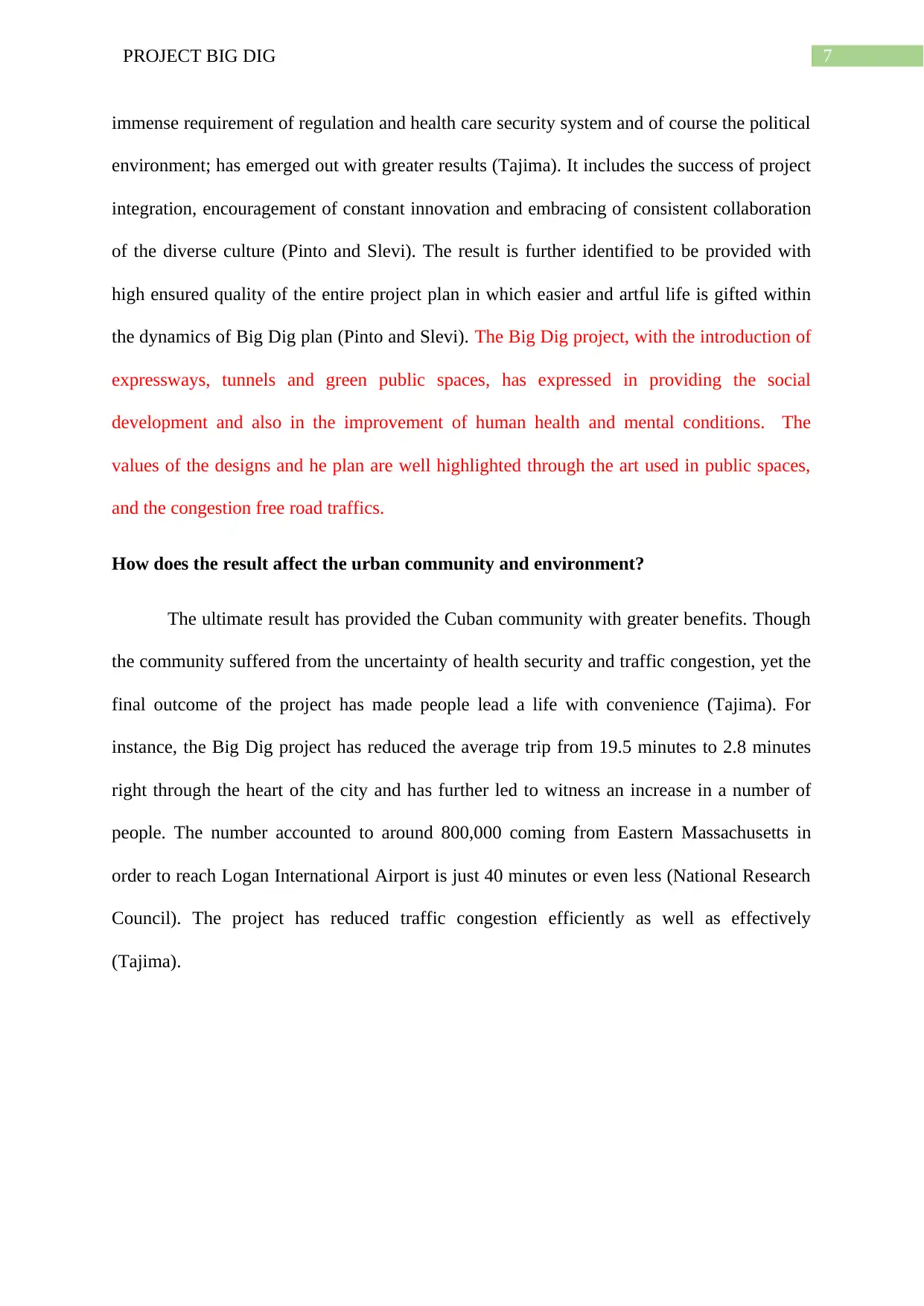
7PROJECT BIG DIG
immense requirement of regulation and health care security system and of course the political
environment; has emerged out with greater results (Tajima). It includes the success of project
integration, encouragement of constant innovation and embracing of consistent collaboration
of the diverse culture (Pinto and Slevi). The result is further identified to be provided with
high ensured quality of the entire project plan in which easier and artful life is gifted within
the dynamics of Big Dig plan (Pinto and Slevi). The Big Dig project, with the introduction of
expressways, tunnels and green public spaces, has expressed in providing the social
development and also in the improvement of human health and mental conditions. The
values of the designs and he plan are well highlighted through the art used in public spaces,
and the congestion free road traffics.
How does the result affect the urban community and environment?
The ultimate result has provided the Cuban community with greater benefits. Though
the community suffered from the uncertainty of health security and traffic congestion, yet the
final outcome of the project has made people lead a life with convenience (Tajima). For
instance, the Big Dig project has reduced the average trip from 19.5 minutes to 2.8 minutes
right through the heart of the city and has further led to witness an increase in a number of
people. The number accounted to around 800,000 coming from Eastern Massachusetts in
order to reach Logan International Airport is just 40 minutes or even less (National Research
Council). The project has reduced traffic congestion efficiently as well as effectively
(Tajima).
immense requirement of regulation and health care security system and of course the political
environment; has emerged out with greater results (Tajima). It includes the success of project
integration, encouragement of constant innovation and embracing of consistent collaboration
of the diverse culture (Pinto and Slevi). The result is further identified to be provided with
high ensured quality of the entire project plan in which easier and artful life is gifted within
the dynamics of Big Dig plan (Pinto and Slevi). The Big Dig project, with the introduction of
expressways, tunnels and green public spaces, has expressed in providing the social
development and also in the improvement of human health and mental conditions. The
values of the designs and he plan are well highlighted through the art used in public spaces,
and the congestion free road traffics.
How does the result affect the urban community and environment?
The ultimate result has provided the Cuban community with greater benefits. Though
the community suffered from the uncertainty of health security and traffic congestion, yet the
final outcome of the project has made people lead a life with convenience (Tajima). For
instance, the Big Dig project has reduced the average trip from 19.5 minutes to 2.8 minutes
right through the heart of the city and has further led to witness an increase in a number of
people. The number accounted to around 800,000 coming from Eastern Massachusetts in
order to reach Logan International Airport is just 40 minutes or even less (National Research
Council). The project has reduced traffic congestion efficiently as well as effectively
(Tajima).
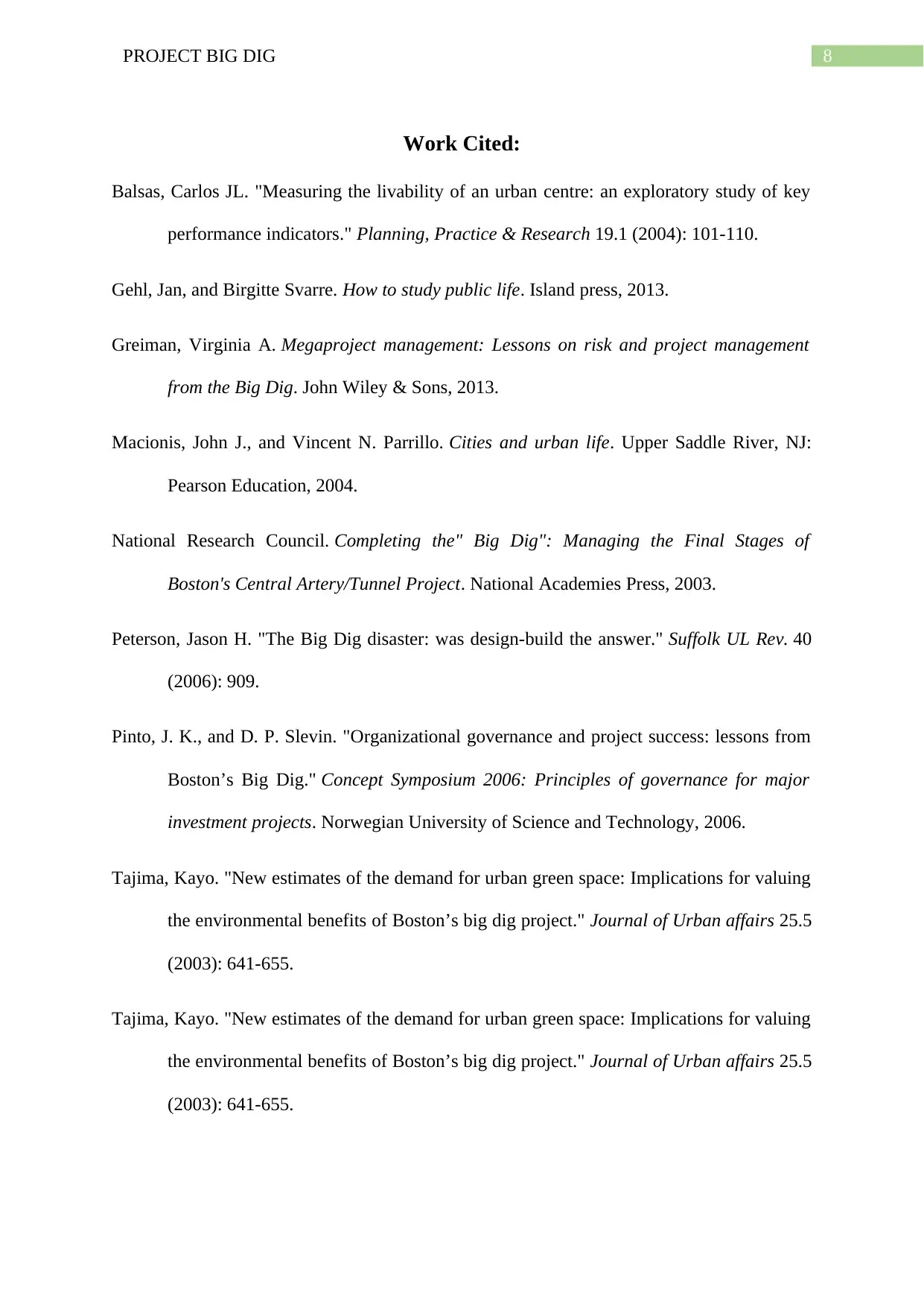
8PROJECT BIG DIG
Work Cited:
Balsas, Carlos JL. "Measuring the livability of an urban centre: an exploratory study of key
performance indicators." Planning, Practice & Research 19.1 (2004): 101-110.
Gehl, Jan, and Birgitte Svarre. How to study public life. Island press, 2013.
Greiman, Virginia A. Megaproject management: Lessons on risk and project management
from the Big Dig. John Wiley & Sons, 2013.
Macionis, John J., and Vincent N. Parrillo. Cities and urban life. Upper Saddle River, NJ:
Pearson Education, 2004.
National Research Council. Completing the" Big Dig": Managing the Final Stages of
Boston's Central Artery/Tunnel Project. National Academies Press, 2003.
Peterson, Jason H. "The Big Dig disaster: was design-build the answer." Suffolk UL Rev. 40
(2006): 909.
Pinto, J. K., and D. P. Slevin. "Organizational governance and project success: lessons from
Boston’s Big Dig." Concept Symposium 2006: Principles of governance for major
investment projects. Norwegian University of Science and Technology, 2006.
Tajima, Kayo. "New estimates of the demand for urban green space: Implications for valuing
the environmental benefits of Boston’s big dig project." Journal of Urban affairs 25.5
(2003): 641-655.
Tajima, Kayo. "New estimates of the demand for urban green space: Implications for valuing
the environmental benefits of Boston’s big dig project." Journal of Urban affairs 25.5
(2003): 641-655.
Work Cited:
Balsas, Carlos JL. "Measuring the livability of an urban centre: an exploratory study of key
performance indicators." Planning, Practice & Research 19.1 (2004): 101-110.
Gehl, Jan, and Birgitte Svarre. How to study public life. Island press, 2013.
Greiman, Virginia A. Megaproject management: Lessons on risk and project management
from the Big Dig. John Wiley & Sons, 2013.
Macionis, John J., and Vincent N. Parrillo. Cities and urban life. Upper Saddle River, NJ:
Pearson Education, 2004.
National Research Council. Completing the" Big Dig": Managing the Final Stages of
Boston's Central Artery/Tunnel Project. National Academies Press, 2003.
Peterson, Jason H. "The Big Dig disaster: was design-build the answer." Suffolk UL Rev. 40
(2006): 909.
Pinto, J. K., and D. P. Slevin. "Organizational governance and project success: lessons from
Boston’s Big Dig." Concept Symposium 2006: Principles of governance for major
investment projects. Norwegian University of Science and Technology, 2006.
Tajima, Kayo. "New estimates of the demand for urban green space: Implications for valuing
the environmental benefits of Boston’s big dig project." Journal of Urban affairs 25.5
(2003): 641-655.
Tajima, Kayo. "New estimates of the demand for urban green space: Implications for valuing
the environmental benefits of Boston’s big dig project." Journal of Urban affairs 25.5
(2003): 641-655.
⊘ This is a preview!⊘
Do you want full access?
Subscribe today to unlock all pages.

Trusted by 1+ million students worldwide

9PROJECT BIG DIG
Winston, Clifford. "Government failure in urban transportation." Fiscal Studies 21.4 (2000):
403-425.
Winston, Clifford. "Government failure in urban transportation." Fiscal Studies 21.4 (2000):
403-425.
1 out of 10
Related Documents
Your All-in-One AI-Powered Toolkit for Academic Success.
+13062052269
info@desklib.com
Available 24*7 on WhatsApp / Email
![[object Object]](/_next/static/media/star-bottom.7253800d.svg)
Unlock your academic potential
Copyright © 2020–2025 A2Z Services. All Rights Reserved. Developed and managed by ZUCOL.



